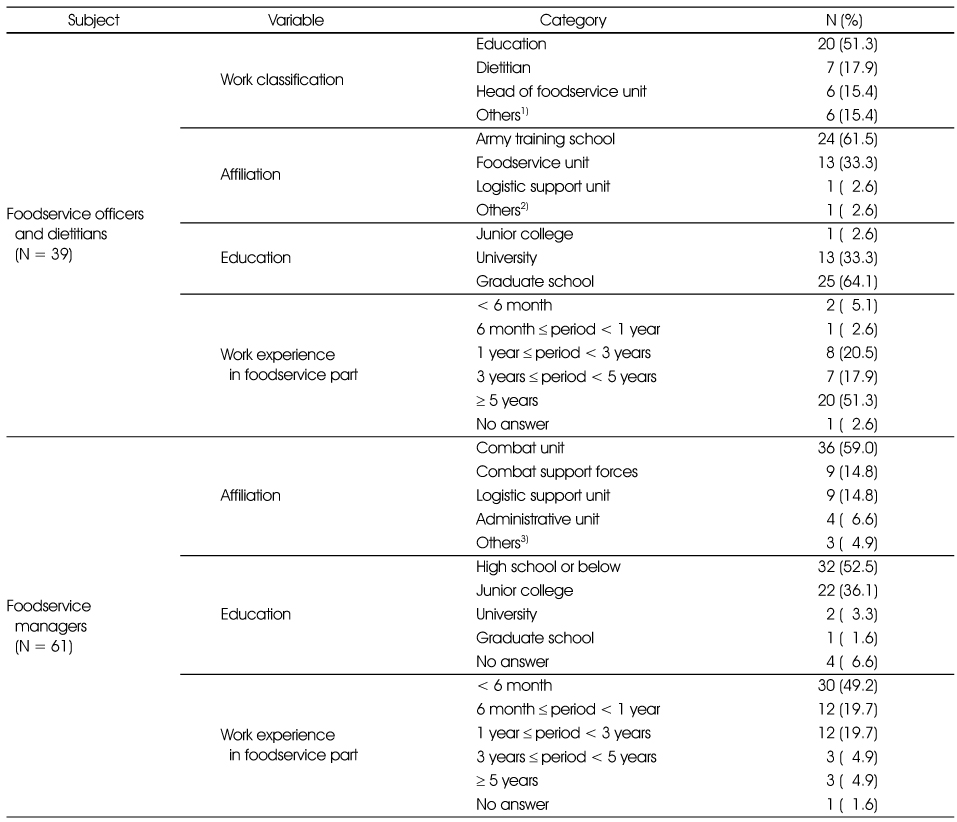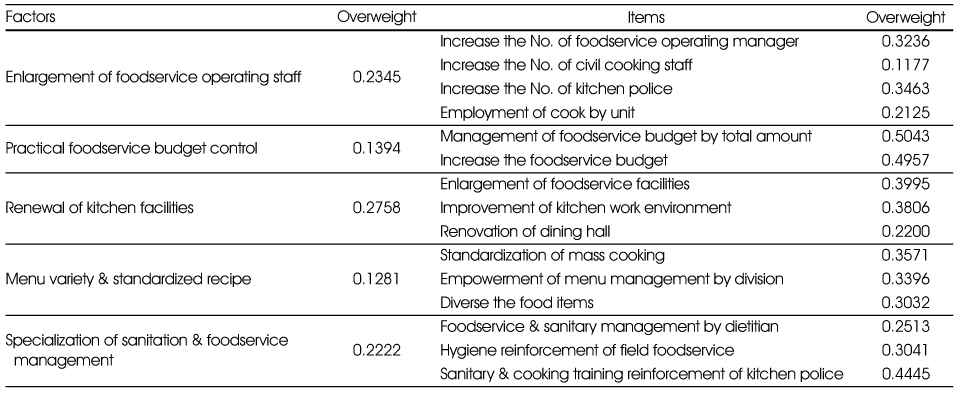References
1. Baek SH, Kim SY. Dietary quality estimation of military foodservice menu. Korean J Food Nutr 2010;23(4):641–648.
2. Baek SH, KIM YS. Investigation of military foodservice operation. Korean J Food Nutr 2010;23(4):615–622.
3. Cha SM, Yang IS, Baek SH, Kim YJ, Jeong JY. Application of analytical hierarchy process in strategy priority decision-making for brand communication by Korean restaurants overseas. Korean J Food Cult 2012;27(3):274–284.
4. Choi DY, Lee IS. Satisfaction of foodservice and eating behavior of male military personnel in Backryung-do. J East Asian Soc Diet Life 2012;22(5):576–584.
5. Choi JS, Choe KS, Moon SH. A study of bakery menu addition in military foodservice. Korean J Culinary Res 2004;10(4):118–132.
6. Jeong SJ. A Survey of Sanitation and Preference for Military Meal Service and Food Behavior and Food Habit of Some Military Personnel Yosu National University; 2006. 8–9.
MS thesis.
7. Kang BK, Lee YE. Measuring attitudes and satisfaction level towards military foodservices. J Korean Soc Food Sci Nutr 2011;40(7):1032–1042.
8. Kang KW. The Study of the Improvement Method of the Military Meal Service Support-Lay Emphasis on Manpower Management- Han-nam University; 2003. 22–25.
28. MS thesis.
9. Kim ES, Jung BM. A survey of satisfaction and preference for military meal service and food behaviors and food habits of some military personnel. Korean J Community Nutr 2006;11(4):520–533.
10. Kim HK, Kim HJ. The development on significancy and priority of KPI in Korea coffee shop business using AHP. Korean J Hosp Adm 2012;21(5):195–205.
11. Kwon KJ. A study on relative importance and priority for measurement item of franchise level evaluation: Using AHP method. J Foodserv Manage 2013;16(3):49–69.
12. Lee HS, Han YS, Lee JM. A survey of the customer satisfaction of military foodservice for their improvement. Korean J Community Nutr 2000;5(3):522–528.
13. Lee JY. Development of the Sanitation Evaluation Tool through Researching of Management Practice at the Military Foodservice Yonsei University; 2006. 23–31.
MS thesis.
14. Lee MA, Yang IS, Yi BS, Kim HA, Park SH. Analytic hierachy process approach to estimate weights of evaluation categories for school foodservice program in Korea. Korean J Nutr 2006;39(1):74–83.
15. Lee MJ, Lee YS. A Survey of satisfaction and preference for military meal services in the Daegu area. Korean J Food Cult 2012;27(2):113–127.
16. Lee YM, Min SH. Preference and perception of seafood among soldiers on cook's duty in military meal service. Korean J Food Cult 2005;20(6):668–674.
17. Lee YM, Lee WJ, Min SH. A study on seafood dishes in military standard menu. Korean J Food Cult 2003;18(3):261–269.
18. Ministry of Education. School foodservice policy 2014 Ministry of Education; 2013. p. 3.
19. Ministry of National Defense. Military foodservice policy 2008 Ministry of National Defense; 2008. p. 1.
20. Ministry of National Defense. Military foodservice policy 2009 Ministry of National Defense; 2009. p. 3.
22. Moon SJ, Sohn KH, Yang IS, Sohn CY, Kim DY. Development in computer program for standardized quantitative recipes in military services. Korean J Food Cult 1991;7(3):61–68.
23. Rao RV. Evaluation of metal stamping layouts using an analytic hierarchy process method. J Mater Process Tech 2004;152(1):71–76.
24. Saaty TL. Highlight and critical points in the theory and application of the analytic hierarchy process. Eur J Oper Res 1994;74(3):426–447.
25. Seo DJ. Quality Improvement Proposition through Menu Preference Survey and Reviews of Transition in Korean Military Food Services Chung-ang University; 2004. 47–49.
MS thesis.
26. Sohn CY, Yang IS. A analysis of relative importance of evaluation categories for hospital foodservice by analytic hierarchy process. Korean J Food Nutr 2010;23(4):470–477.
27. Sohn GR, Park MJ, Youn MS, Jeong YH. Soldier satisfaction with military foodservice. J East Asian Soc Diet Life 2006;16(5):607–614.
29. Vaidya OS, Kumar S. Analytic hierarchy process: An overview of applications. Eur J Oper Res 2006;169:1–29.
30. Yeo WS. Study of menu variety in military foodservice. Korean J Culinary Res 2004;10(41):140–152.




